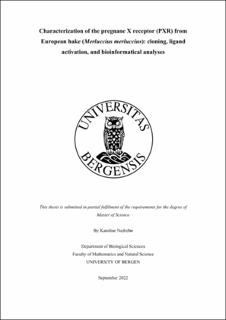| dc.description.abstract | As a response to adverse environmental conditions, organisms have throughout evolution generated a collection of gene families and pathways providing protection and repair of damage caused by physical, chemical, and biological stressors (the defensome). A network of genes and diverse metabolic pathways comprise the chemical defensome, which allows the organism to detect diverse compounds and orchestrate a defense against the potentially toxic chemicals. The chemical defense system constitutes efflux transporters transporting compounds out of the cells when they enter and after they have been metabolized (Phase 0 and III), detoxifying enzymes that transform compounds to inactive- or more easily eliminated metabolites (Phase I-II), and soluble receptors and ligand-activated transcription factors that function as sensors of diverse compounds. The pregnane X receptor (PXR) is a ligand-activated transcription factor belonging to the nuclear receptor (NR) superfamily, and it is also known as NRI12. PXR is activated by a variety of ligands, including both endobiotic and xenobiotic compounds, and subsequently regulates the expression of different genes involved in biotransformation (transporters, CYP genes, genes encoding conjugating and reducing enzymes) as a response to the detected compound. As PXR constitute an important role as xenosensor, and an essential member of the chemical defensome, more studies have focused on its ligand-binding properties and function as a regulator of stress in different species. Interestingly, a recent study reported the loss of pxr in most of the species belonging to the Gadiformes order, including Atlantic cod (Gadus morhua), however, the pxr gene was apparently retained in the European hake (Merluccius merluccius). This raises interesting questions from an evolutionary and toxicological perspective, regarding the physiological role and function of PXR in European hake. This study aimed to characterize PXR in the European hake on a molecular and functional level by performing primary structure- and phylogenetic analysis, and by assessing its potential transcriptional activation induced by different xenobiotics. This study provided supporting evidence that diverse changes to the pxr gene have occurred throughout evolution, and more closely related species were shown to have more similar PXR protein sequences (hake clustered with teleost fish in the phylogenetic three). Furthermore, pxr from hake was cloned and used to establish an in vitro luciferase gene reporter assay, where transcriptional activity of hakePXR was successfully induced by clotrimazole (known agonist for zebrafish PXR). Thus, this study provides important evidence for PXR functionality in European hake and suggest its role as a xenosensor is conserved in European hake. | |
